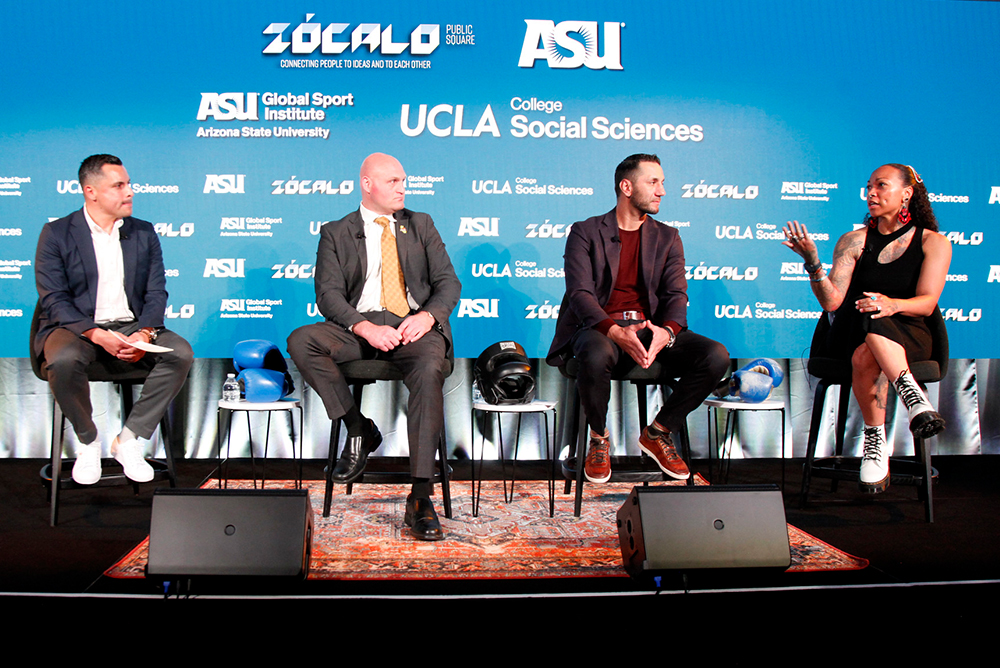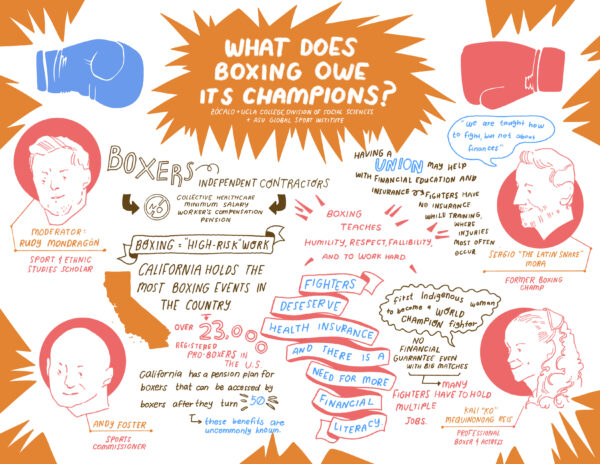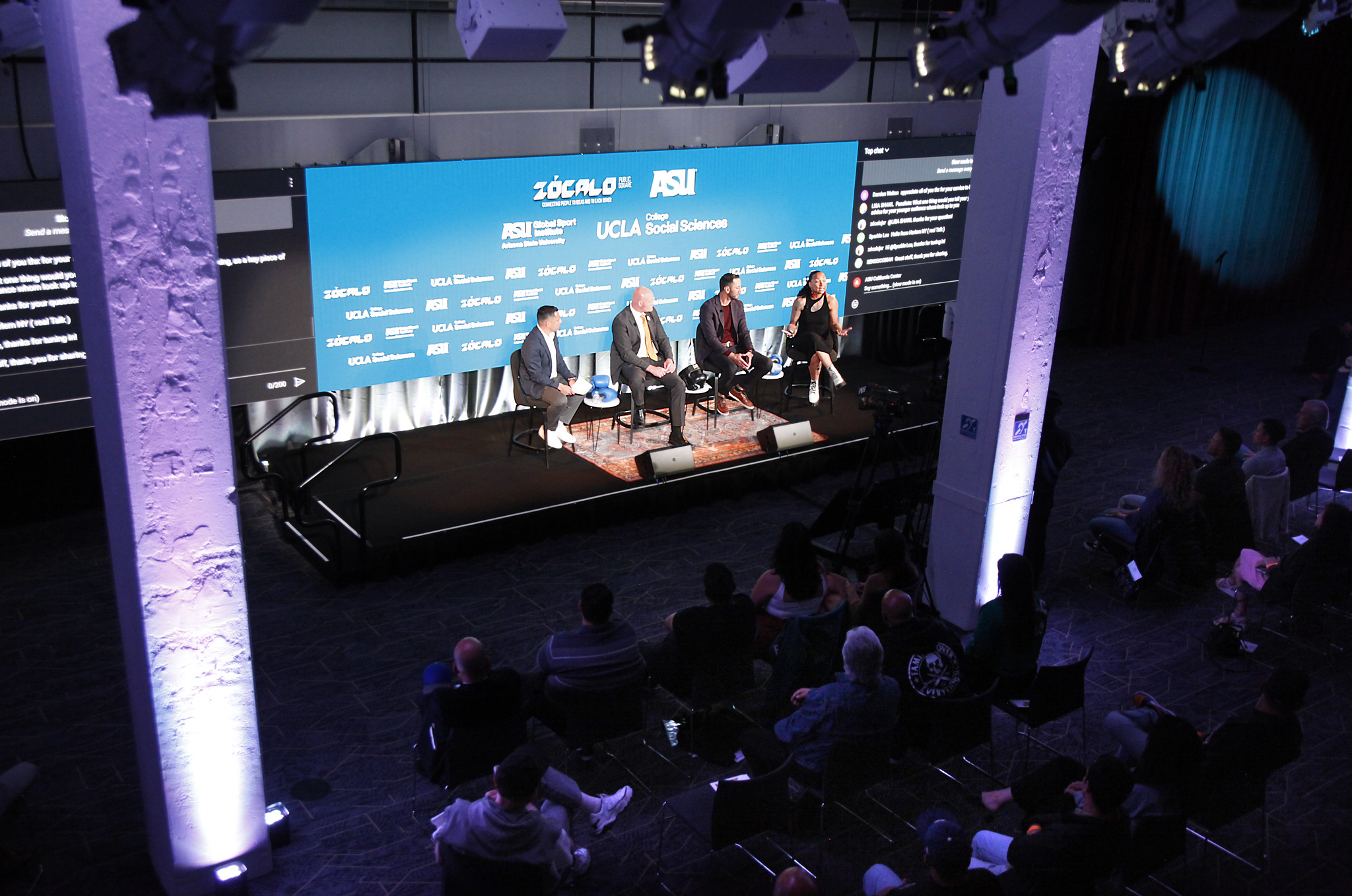
From left to right: Rudy Mondragón, Andy Foster, Sergio “the Latin Snake” Mora, and Kali “KO” Mequinonoag Reis.
Boxing has big pictures (Raging Bull, Creed), big personalities (Muhammad Ali, the original G.O.A.T.), and big spectacles (pay-per-view fights adorned with flashing lights, raucous crowds, and stylized ring entrances). You might be forgiven for thinking that being a professional fighter translates into making big money.
But the challenges contemporary boxers face are not only physical and mental, but overwhelmingly financial. This begs the question: What does boxing owe its champions? This was the title of last night’s Zócalo program, presented in partnership with UCLA College, Division of Social Sciences and ASU Global Sport Institute. It all came down to, as moderator Rudy Mondragón put it, “centering the boxer as the worker.”
Mondragón, a scholar of ethnic and sports studies at UCLA, was joined on stage at the ASU California Center in downtown Los Angeles by California State Athletic Commission executive director Andy Foster, former middleweight champ and DAZN host Sergio “the Latin Snake” Mora, and professional boxer and actress Kali “KO” Mequinonoag Reis.
Before diving in, Mondragón noted that boxers are independent contractors with no employee-employer relationships, as in other professional sports leagues. This usually means no collective healthcare, minimum salary, workers compensation, or pension. The lack of security hits harder because boxing is such “high risk work”: many professional boxers wind up physically unwell and penniless in their later lives. Any story of progress for boxing will require “igniting conversations and potential future action that will require collective effort among all boxing stakeholders,” Mondragón added later.
“I believe that fighters have distinct stories,” he said. Turning first to Reis, he asked her to tell hers.
Raised in East Providence, Rhode Island, Reis is a member of the Seaconke Wampanoag Tribe and is the first Indigenous woman to become a World Champion fighter. She is the baby in a family of five and described her upbringing as artistic, musically-inclined, and focused on playing sports.
“The solo aspect of boxing was intriguing,” she said. “In boxing, you have to be self-accountable.” When she asked people to help her learn the sport, they repeatedly told her that she should probably “do girl things” instead. But Reis persisted, eventually convinced a fighter in her community to teach her, and joined a gym at the age of 14. “It was love at first punch.”
Mora, who was born and raised in East Los Angeles, shared three influences that led him down the boxing-as-a-career trajectory. The first was knocking out his friends when they sparred at community BBQs—what he calls the East L.A. version of The Little Rascals—through which he learned that he was a good fighter. Second was needing high school credit and, thus, enrolling in a program that included boxing as a sport credit. And third, a police officer mentor reassured Mora that no matter what happened with fighting, he would always have other career options, including becoming a police officer himself. This mentor encouraged him to at least give the sport a real shot.
But it was being selected for the reality television show The Contender that launched Mora’s financial success. The show featured professional boxers as contestants and, in true reality TV fashion, they lived under one roof and they sparred. Mora won the first season. The prize: a million dollars.
When he joined The Contender, Mora was in the red (“I had minus $150,” he said) and his highest paycheck from a fight had been $11,000 (“I thought I was rich!”). But that was by no means good enough to carve out and sustain a living. “A reality show saved me,” Mora later stated, more pointedly.
Mora’s and Reis’s stories, though distinct, coalesced and intersected throughout the evening’s conversation. They described hustling, moving in and out of various gigs and jobs, and struggling through poverty. “I just did whatever I could do,” Reis said. She braided hair, fixed motorcycles, was a waitress, personal trainer, club security guard, and a residential counselor at a group home for girls. It got so bad, she said, that she had to file as homeless to receive an Electronic Benefits Transfer (EBT) card.
Mora cut his friends’ hair for $3 a pop. “I never really had a job. I never applied for a job,” he said.
Both fighters described moving up from the “B side.” Foster jumped in to explain.
“I’m concerned with the B side. Those people don’t have anybody,” he said. Promoters who have signed boxers typically set up matches that allow their boxers to win. The B side boxer is the other guy: the “underdog” or “underside” of the match ticket—somebody with no manager and no promoter, the person they “bring in to lose.” The B side boxer has to be competitive enough for the Commission to approve the fight, but shouldn’t be good enough to win, Foster said. In the past, B siders often received just $1 to fight.
Mondragón highlighted some progress on this front: Under Foster’s leadership, in 2016, a regulation passed that outlawed the $1 contract.
The panelists discussed other promising solutions to make the industry of boxing more fair and stable, especially in California. Since there is no centralized governance of boxing, states regulate boxing differently. California regulates the most boxing events in the country and is home to the largest share of the over 23,000 registered professional boxers (3,300 males, 150 females). In 1982, Foster said, the state launched a pension program for boxers funded by ticket sales (not taxes).
When a boxer turns 50 they can access those funds, but many boxers don’t know about this. Mora himself has a pension, having fought in California, and found out about it only three weeks ago after talking to Mondragón about this event. As a remedy, Foster’s commission has hired investigators to look for these fighters, and has worked with the Mexican Consulate since many fighters with “lost” pensions are Mexican nationals.
Beside getting access to the pension, Foster, Reis, and Mora all advocated securing health insurance for fighters—perhaps through unionization—and acknowledged a need for better financial literacy. “Financial education is the main thing I would want fighters to be a part of,” Mora said.
As Mondragón wrapped up the discussion, online audience questions poured in. One asked the boxers: What is one thing you’d want to tell your younger self as a key piece of advice for those that look up to you now?
Mora didn’t hesitate: “There’s a great lesson in getting your butt kicked. Every kid needs to get their butt kicked. It teaches you humility, it teaches you respect for another person, it teaches you that you’re fallible, it teaches you that you need to work hard.”






Send A Letter To the Editors